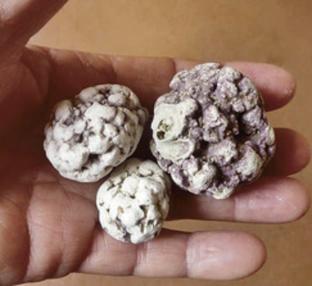Published in the Ocean Watch column, Honolulu Star-Advertiser © Susan Scott
October 24, 2011
Stony seaweeds are hard in more ways than one.
My visiting niece recently collected a handful of warty, purple-and-white spheres on a North Shore beach. She though they were coral.
“No,” I said. “They’re a kind of seaweed called coralline algae.”
Seaweeds have never been my passion, so the name was all I knew about those plants. And I wasn’t even sure about that. Some sources call stony seaweeds calcareous algae.

Photo by Susan Scott
These rhodoliths are a type of coralline algae.
New Zealand marine biologist Paddy Ryan writes in his book, “The Snorkeler’s Guide to the Coral Reef” (UH Press, 1994), “Coralline algae have incredibly complicated life cycles, possibly the most complex in the entire plant kingdom.” A Wikipedia contributor noted that despite their ubiquity, crustose coralline algae are poorly known, even by phycologists, the experts.
Well, that’s a relief, because I found it hard to even sort out these seaweeds’ names. What’s crustose?
Most of us think of seaweeds as soft and flexible, but some seaweeds are rock-hard because their cell walls contain calcium carbonate. This compound is found just about everywhere in the ocean. Snail shells, bivalve shells and pearls are made of calcium carbonate, as are the skeletons of stony corals, sea urchins and sponges, and most white sand.
Some calcium carbonate-hardened seaweeds grow between stony coral colonies, cementing them together. Other stony algae grow in sheets or crusts (crustose!), creating reef flats and the tough tops of the fringing reefs that surround most of Hawaii.
Besides helping to keep the corals from drying out during low tides, these sturdy seaweeds create reefs with fortresslike strength. Without seaweed Super Glue, corals could not survive the pounding surf.
All seaweeds that produce calcium carbonate in their cell walls are called calcareous algae. Some green species familiar to Hawaii snorkelers are in a group called Halimeda, which have blades resembling little paddles. A significant amount of sand on the ocean floor and Hawaii’s beaches comes from dead Halimeda.
Some corallines are encrusting, some have branches and others form balls called rhodoliths that roll around the sea floor until they grow heavy enough to settle down. It was some of these tumbled rhodoliths that my niece found.
During all my years of admiring coral reefs, I never much noticed how the whole works is cemented together. Now I can’t help but notice.
“See anything interesting?” my husband said when I came in from snorkeling a few days ago.
“Yes,” I said. “Seaweed.”